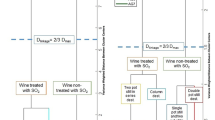Abstract
One of the purposes of chemical analysis is to find quick and efficient methods to answer complex analytical questions in the life sciences. New analytical methods, in particular, produce a flood of data which are often very badly arranged. An effective way to overcome this problem is to apply chemometric methods. As part of the following investigations, three brands of oregano were analysed to identify their volatile aroma-active compounds. Two techniques were applied—gas chromatograpy–olfactometry (GC–O) and human sensory evaluation. Aroma-impact compounds could be identified in the main brands of oregano with the aid of chemometric methods (principal-components analysis, hierarchical cluster analysis, linear discriminant analysis, partial least-squares regression). Therefore, it is possible to reduce the analysis of sensory and olfactometry to relevant attributes. This makes classifying new species easier, much faster, and less expensive and is the premise for quick and more economic identification of new potential genotypes for oregano plant breeding. A comprehensive list of oregano key odourants, determined by GC–O and human sensory evaluation using different methods of supervised and unsupervised pattern cognition, has not previously been published.

Oregano - a multi-faceted herb




Similar content being viewed by others
Abbreviations
- GC–O:
-
Gas chromatograpy–olfactometry
- PDMS:
-
Polydimethylsiloxane
- SBSE:
-
Stir-bar-sorptive extraction
- ODP:
-
Olfactory detector port
- TDU:
-
Thermal desorption unit
- MS:
-
Mass spectrometry
- PTV:
-
Programmed temperature vaporiser
- CA:
-
Cluster analysis
- FA:
-
Factor analysis
- PLS:
-
Partial least-squares regression
- NIF:
-
Nasal impact factor
- TIC:
-
Total ion current
References
Meilgaard M, Civille GV, Carr BT (1999) Sens Eval Technol:123–133, CRC Press, Inc., Boca Raton, FL
Baltussen E, Sandra P, David F, Cramers C (1999) J Microcolumn Sep 11(10):737–747
Blum C (1999) Thesis. University of Hamburg, Hamburg
Adams RP (1995) Identification of essential oil components by gas chromatography/ mass spectrometry. Allured Publishing Corporation Carol Stream, Illinois
NIST 2002 (US National Institute of Standards and Technology, Washington, D.C.), Adams (Allured Publishing, Carol Stream, IL), 6th edn, Wiley, New York
Weber E (1986) Grundriß der biologischen Statistik, 9th edn. Fischer, Jena
Malinowski ER (1992) J Chemometr 6:29–40
Lachenbruch PA (1975) Discriminant analysis. Hafner Press, London
Wold S, Ruhe A, Wold H, Dunn WJ (1984) J Sci Stat Comput 5:735
Einax JW, Aulinger A, von Tümpling W, Prange A (1999) Fresenius J Anal Chem 363:655–661
Van den Dool H, Kratz PD (1963) J Chromatogr 11:463–471
Azizi A, Yan F, Honermeier B (2009) Ind Corp Prod 29:554–561
Loizzo M, Manichini F, Conforti F, Tundis R, Bonesi M, Saab AM, Statti GA, de Cindio B, Houghton PJ, Manichini F, Frega NG (2009) Food Chem (in press)
Pasquier B (1996) In: Padulosi S (ed) Oregano. Rome (Italy)
Bernàth J (1996) In: Padulosi S (ed) Oregano. Rome (Italy)
Milos M, Mastelic J, Jerkovic I (2000) Food Chem 71:79–83
De Mastro G (1996) In: Padulosi S (ed) Oregano. Rome (Italy)
Leto C, Salamone A (1996) In: Padulosi S (ed) Oregano. Rome (Italy)
Pino JA, Borges P, Roncal E (1993) Alimentaria 244:105–107
Arnold N, Bellomaria B, Valentini G, Arnold HJ (1993) J Essential Oil Res 5:71–77
Ruberto G, Biondi D, Meli R, Piattelli M (1993) Flavour Fragrance J 4:197–200
Vokou D, Kokkini S, Bessiere JM (1988) Econ Bot 42:407–412
Author information
Authors and Affiliations
Corresponding author
Rights and permissions
About this article
Cite this article
Bansleben, AC., Schellenberg, I., Einax, J.W. et al. Chemometric tools for identification of volatile aroma-active compounds in oregano. Anal Bioanal Chem 395, 1503–1512 (2009). https://doi.org/10.1007/s00216-009-3090-4
Received:
Revised:
Accepted:
Published:
Issue Date:
DOI: https://doi.org/10.1007/s00216-009-3090-4




